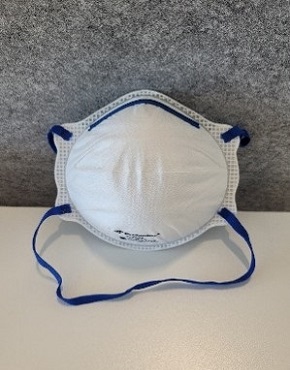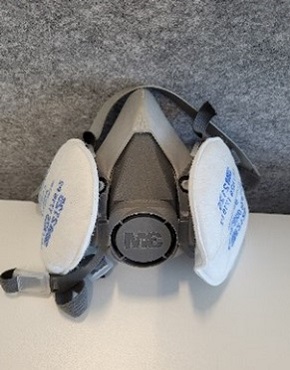Respiratory protective equipment and requirements for fit testing workers
Information about respiratory protective equipment and requirements for fit testing and fit checking workers.
Workers can be exposed to airborne contaminants at work. These airborne contaminants can be hazardous to a worker’s health when inhaled. Respiratory protective equipment (RPE) is a form of personal protective equipment (PPE) to protect workers from breathing in:
- dusts e.g. silica
- fibres e.g. asbestos
- mists
- fumes
- vapours
- gases
- micro-organisms e.g. viruses and bacteria.
In many workplaces RPE is used to minimise exposure when used with other control measures. Correct information on the selection, fit and use of RPE is crucial to its effectiveness as a control measure.
On this page
- Types of RPE
- Employer responsibilities
- Why fit testing is needed
- How respirator fit testing works
- Respirator fit checking
Types of RPE
There are two main types of respirators:
- Air-purifying respirators – protects the wearer by filtering contaminated air.
- Non-powered – uses the wearer’s breathing to draw in air through a filter
- Powered air-purifying respirators (PAPR) – purifies contaminated air using a powered unit. The unit delivers filtered air to the workers breathing zone via a hose. They can be used with a facepiece, hood or helmet head covering.
- Supplied-air respirators – protects the wearer by supplying clean breathing air from an independent source such as an air compressor.
Close fitting respirators (also known as tight fitting) can consist of half or full face-piece respirators (masks) which may be disposable (e.g. P2/N95) or reusable with filters attached.


Image: close fitting disposable respirator (left/top image) and close fitting reusable respirator (right/bottom image)
Respirators come in different shapes and sizes – one size will not fit everyone. Workers must be individually fit tested to ensure there is an adequate face seal between their face and respirator.
Employer responsibilities
Under WHS law, a Person Conducting a Business or Undertaking (PCBU) must ensure the health and safety of workers and other persons at the workplace. A PCBU should apply a risk management approach to eliminate and/or minimise risks so far as is reasonably practicable.
A PCBU may provide personal protective equipment (PPE) to workers to manage risks to the health and safety of workers in accordance with the hierarchy of controls (cl 36). Where PPE is used to minimise a risk to health and safety, Clause 44 of the WHS Regulation (NSW) 2017 applies.
Any PCBU that provides PPE to workers at a workplace must ensure that the PPE is:
- selected to minimise the risk to health and safety and is suitable for the nature of the work and the hazard associated with the work, and
- a suitable size and fit and reasonably comfortable for the worker who is to use or wear it.
A PCBU is also required to provide workers with information, training and instruction in the proper use and wearing of PPE and storage and maintenance.
The video below explains how to properly wear and look after a mask.
You can also watch this video in Arabic, Mandarin or Vietnamese on YouTube.
Respiratory protection program
Where RPE is used as a control measure, a PCBU should put in place a respiratory protection program. A RPE program includes:
- risk assessment and reports indicating exposure levels for airborne contaminants
- medical evaluation to ensure the worker is physiologically and psychologically suited to wear RPE
- respirator selection – information used to select respirators
- fit testing to determine facial fit
- fit checking procedures
- procedures for proper use in routine and emergency situations
- respirator cleaning
- maintenance
- storage requirements
- filter changes when required
- training in the correct use, storage and maintenance of RPE.
Why fit testing is needed
Fit testing detects for air leaks around the seal between the respirator facepiece and the face of the worker. If there isn’t a good face seal, contaminated air will leak into the respirator and the wearer may not get the level of protection that is needed.
Fit testing is required for all types of close fitting half and full facepiece respirators.
Fit testing is not required for positive pressure loose fitting head tops or hoods connected to PAPR or a compressed airline hose. Workers who are not clean shaven above the cheeks, neck and jaw must not be provided with close fitting RPE as it prevents a good seal.
How respirator fit testing works
There are two methods of fit testing that meet Australian Standards (AS/NZS 1715:2009 Selection, use and maintenance of respiratory protective equipment).
The qualitative method is a pass/fail test where you have to report if you can taste or smell a test agent. It can only be used for half-face respirators.
The quantitative method uses specialised equipment to measure how much air leaks into the respirator. It can be used for half- and full-face respirators.
Fit testing must be carried out on workers who are clean shaven or have no hair between their face and the fitting surfaces of the respirator face piece.
All fit testing must be carried out by a competent in-house person, manufacturer, supplier or consultant:
- before wearing a close fitting respirator for the first time
- each time a new make or model of respirator is issued
- whenever there is a change in the wearer’s facial characteristics or features which may affect the seal (for example, weight loss or gain)
- at least annually.
Keep a written record of fit tests carried out for each worker, including the:
- type of test performed.
- make, model, style and size of respirator tested.
- date and result of the test.
If you are a PCBU wanting to carry out in-house testing, you should consider buying your own fit testing equipment and having an employee become an accredited fit tester.
Find an accredited training providers or consultants on the RESP-FIT website.
Respirator fit checking
A fit check should be carried out every time a worker puts on a close fitting respirator. This is a quick check to ensure that a respirator (which has already been fit tested) has been put on correctly. There should be a good seal between the respirator and face. A positive-pressure or negative-pressure seal check can be done.
A positive-pressure check means:
- blocking the valve where your breath escapes on a half or full facepiece respirator, or
- covering the respirator surface on a filtering facepiece (disposable type), usually by using your hands, and trying to breathe out.
If slight pressure builds up, it means air isn’t leaking around the edges of the respirator.
A negative-pressure check means:
- blocking the intake valves (where air comes in) on a half or full facepiece respirator, or
- covering the respirator surface on a filtering facepiece (disposable type), typically using your hands and trying to breathe in.
If no air enters, the seal is tight.
Videos showing respirator fit testing and fit checking can be found on the Breathe Freely Australia website.
Related information
Find translated health and safety resources on our website.